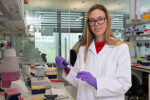

The human brain is greatly enlarged even compared with our closest relative, the other great apes. This enlargement happens during in utero development, but the cellular and molecular mechanisms are still unclear. To figure out how this happens, we use an in vitro model of developing human brain tissue called brain organoids, also called cerebral organoids. Formed from pluripotent stem cells, including embryonic stem cells, brain organoids recapitulate the early events of embryonic brain development remarkably well. They make the same neural stem cells that give rise to neurons and astrocytes of the cerebral cortex, and those cells go on to form functioning neural circuits.
To uncover the molecular mechanisms of our unique evolutionary brain enlargement, the lab performs a variety cellular and molecular analyses, including advanced light sheet imaging, single cell transcriptomics, and comparative epigenetic assays such as Cut&TAG, ATAC-seq, and DNA methylation analysis, all in the context of human compared with chimpanzee and gorilla organoids. We have uncovered a key stage of early expansion of human neural stem cells when a range of genes are expressed differently in human.
This project will focus on specific genetic changes in the human genome and perform advanced manipulations including locus swapping, large scale rearrangement, and chromosome transfer, to investigate which human-specific regions are responsible for the unique behaviour of human neural progenitors. The successful student will learn stem cell and organoid techniques, advanced genetic manipulation methods such as CRISPR, light microscopy, tissue histological methods, biochemistry, and next generation sequencing methods including multi-omics readouts.
References
An early cell shape transition drives evolutionary expansion of the human forebrain.
Cell 184(8): 2084-2102.e19 (2021)
Cerebral organoids model human brain development and microcephaly.
Nature 501(7467): 373-9 (2013)
Calcium dynamics tune developmental tempo to generate evolutionarily divergent axon tract lengths
bioRxiv: (2024) preprint
Brain organoids for the study of human neurobiology at the interface of in vitro and in vivo.
Nat Neurosci 23(12): 1496-1508 (2020)